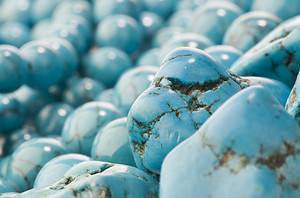Pearls are precious and fascinating, not just because they’re shiny and attractive, but also because of how they form. These beautiful gems are formed by a completely natural process by creatures that live deep within the sea. Humans have been fascinated with pearls for years, but one other thing we’re starting to learn about them is how big they can get. There are some pretty huge pearls on record, but what do you picture in your mind when you think of the biggest pearl? Do you picture a round, perfectly-shaped pearl, shining in all its iridescent splendor? Or did you know that some types of pearls are not so shapely, but also fall into that category of “pearls”?
Join us as we delve into the mystery behind the two main types of pearls: nacreous and non-nacreous. Technically, each category has its own claim to fame, as in, “biggest pearl.” And then again, there are some unofficial contenders for the top spot. Read on to learn the answer: What is the biggest pearl in the world?
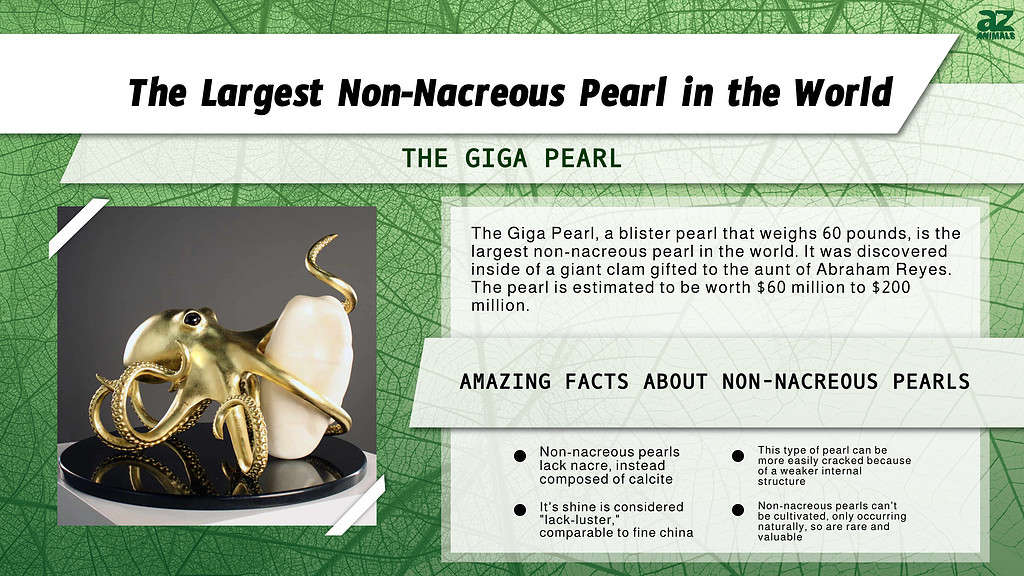
Nacreous vs. Non-nacreous Pearls: It’s All in the Luster
The special luster that classic pearls display is known technically as nacre. Nacre is the substance from which nacreous pearls are formed, a combination of conchiolin and calcium carbonate (aragonite). Oyster mollusks secrete nacre, which forms layers around debris that gets trapped in the oyster shell over time, forming nacreous pearls. Some types of nacreous pearls are Akoya pearls, Faijian pearls, South Sea pearls, Golden South Sea pearls, and Tahitian pearls. Nacreous pearls can vary is shape from round specimens to baroque (irregular).
The value of a nacreous pearl is determined by its size, shape, color, smoothness, and most importantly, its luster. While some nacreous pearls are natural, others are cultivated. But either way, their nacre determines their quality.
Non-nacreous pearls lack nacre. They are instead composed of calcite and are considered calcareous concretions. These types of pearls only occur naturally–they can’t be cultivated. Non-nacreous pearls can be more easily cracked because of a weaker internal structure. They are also “lackluster”–their shine can be compared to that of porcelain. However, these pearls are still very valuable, as they only occur naturally and are rare finds. The most known types of non-nacreous pearls are Conch and Melo Melo.
The World’s Biggest Nacreous Pearl: Pearl of Asia
What is believed to be the world’s largest known nacreous pearl currently in existence is the illustrious Pearl of Asia, a prized pearl that dates back to the 17th century. This 600-karat baroque-shaped pearl is 3 inches tall, and is believed to have been found in the Persian Gulf. It became known when it showed up in India and came into the possession of the King of Persia. He later gifted it to the Chinese Emperor Qianlong. Eventually, this special natural pearl made its way to the West and is now set in a motif that resembles a group of fruits.
In 2005, the Pearl of Asia was displayed at the Smithsonian National Museum of Natural History in an exhibit called “The Allure of Pearls.” This exhibit features 12 rare pearls, including the Hope Pearl, the Black Beauty, La Peregrina, the Drexel Pearl, the Pearl of Kuwait, the Queen Mary Brooch, the South Sea Drops, the Survival Pearl, and the Paspaley Pearl (known as the largest spherical cultured pearl in the world).
The World’s Biggest Non-Nacreous Pearl: The Giga Pearl
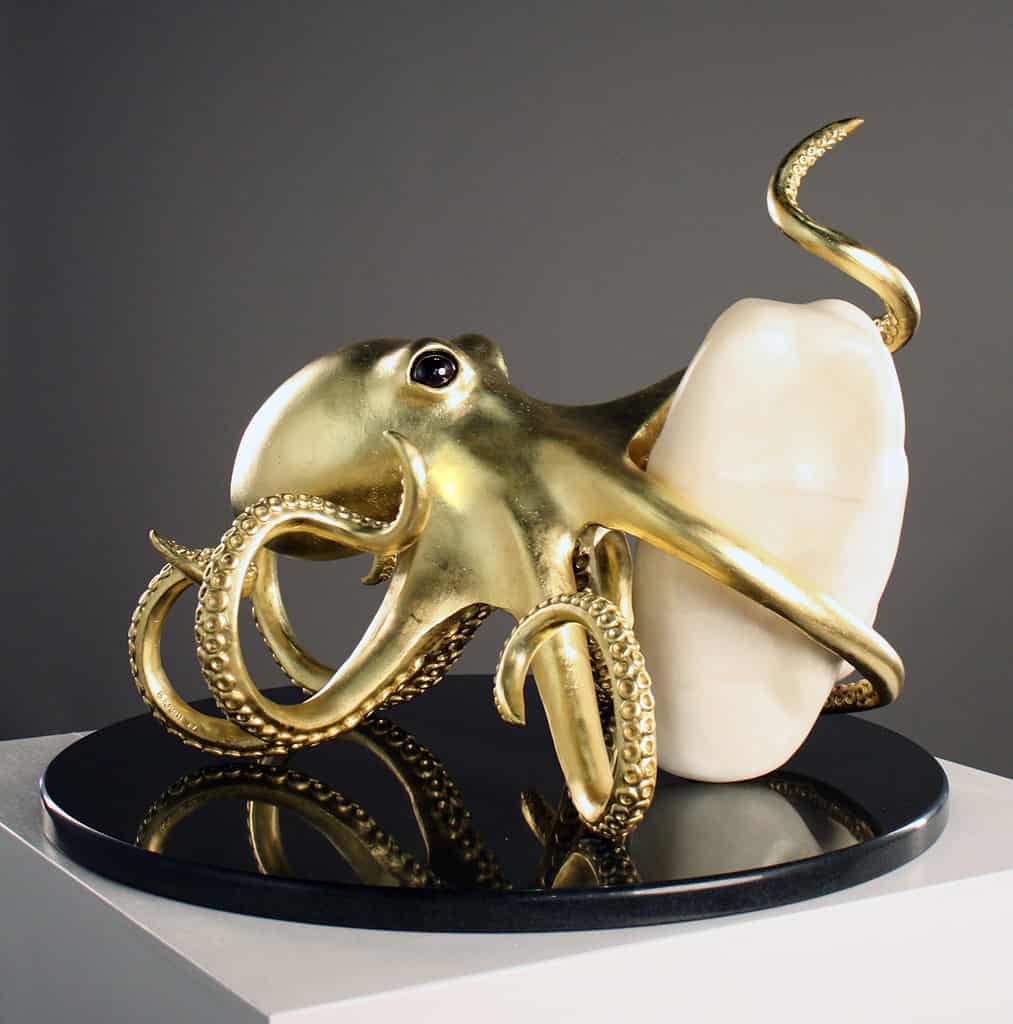
The Giga Pearl is the largest authenticated non-nacreous pearl in the world.
©Roxrsch / CC BY-SA 4.0 – License
In the past, the Pearl of Allah was considered the largest non-nacreous pearl in the world, having emerged on the world in the Philippines around 1934, weighing 14 pounds and measuring 9.45 inches in diameter. But this early legendary “clam pearl” was knocked out of the top spot by the Giga Pearl, a stunning blister pearl that weighs in at 60 pounds and is four times the size of the Pearl of Allah. The Giga Pearl was officially certified by the GIA (Gemological Institute of America) as being the world’s largest non-nacreous pearl.
The Giga Pearl came into the hands of its current owner Abraham Reyes via his aunt, who was gifted a giant clam called a Tridacna gigas, purchased from a Filipino fisherman in 1959 by Reyes’ grandfather. These clams are the largest in the world and can weigh as much as 500 pounds and grow as wide as 4.5 feet. Can you wonder at the surprise they must have felt at finding the enormous pearl inside? Still in the hands of the family, the pearl is displayed with a 22-karat gold leaf octopus sculpture and is estimated to be worth between $60 million to $200 million.
A Contender for the World’s Biggest Pearl: Pearl of Puerto
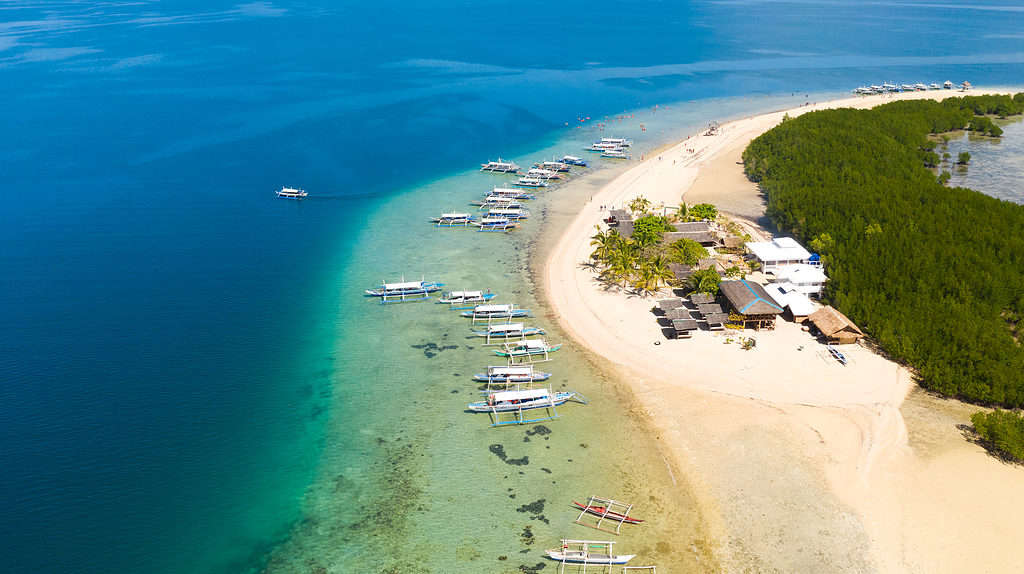
The Pearl of Puerto was found in the Philippines Sea near Puerto Princesa. Pictured is
Starfish
Island, a small island near Puerto Princesa.
©Tatiana Nurieva/Shutterstock.com
Like many beautiful things, this record-breaking Pearl of Puerto was an accidental discovery. While fishing in the sea off Palawan Island, an anonymous Filipino fisherman found a huge clam that caught his attention.
He was in the water to remove the ship’s anchor from the bottom due to an imminent storm. The fisherman retrieved the clam and took it back with him to the surface. He only noticed the enormous pearl while attempting to cook the clam.
Unsurprisingly, the unidentified fisherman kept this treasure under his bed for 10 years after discovering it in 1996. Not knowing its worth, he simply kept the pearl as a good luck charm for fishing days. He believed touching the pearl would provide him with an abundance of fish to catch. Due to a change of residence, the unnamed fisherman decided to hand over the pearl. The true value of the pearl only became known after he gave it to his relative, Aileen Cynthia Maggay-Amurao, who was a tourist officer in Puerto Princesa. Maggay-Amurao posted the pearl on Facebook, inviting gemologists to come to Puerto Princesa to examine it for authenticity. After estimating its value, this pearl was found to be worth $93 million in 2003.
Features of the Pearl of Puerto
This enormous, atypically formed pearl currently holds the title of the largest pearl in the world. The Pearl of Puerto is approximately 2.2 feet long and one foot wide. It has an enormous weight of 75 pounds. The 170,000-carat pearl surpasses the previous record-holder, the 60-pound, $90+ million Giga Pearl. But the Pearl of Puerto has not yet been officiated as the ultimate monster of all pearls.
The Pearl of Puerto has received a lot of accolades from the press, including CNN, Forbes magazine, NPR, and has even been written up in the Smithsonian Magazine. There’s no denying that this giant of a pearl is a contender to possibly overtake the Giga Pearl as becoming the official “biggest pearl in the world.” But for now, the Giga Pearl still holds the official title.
The Location of the Biggest Pearl in the World
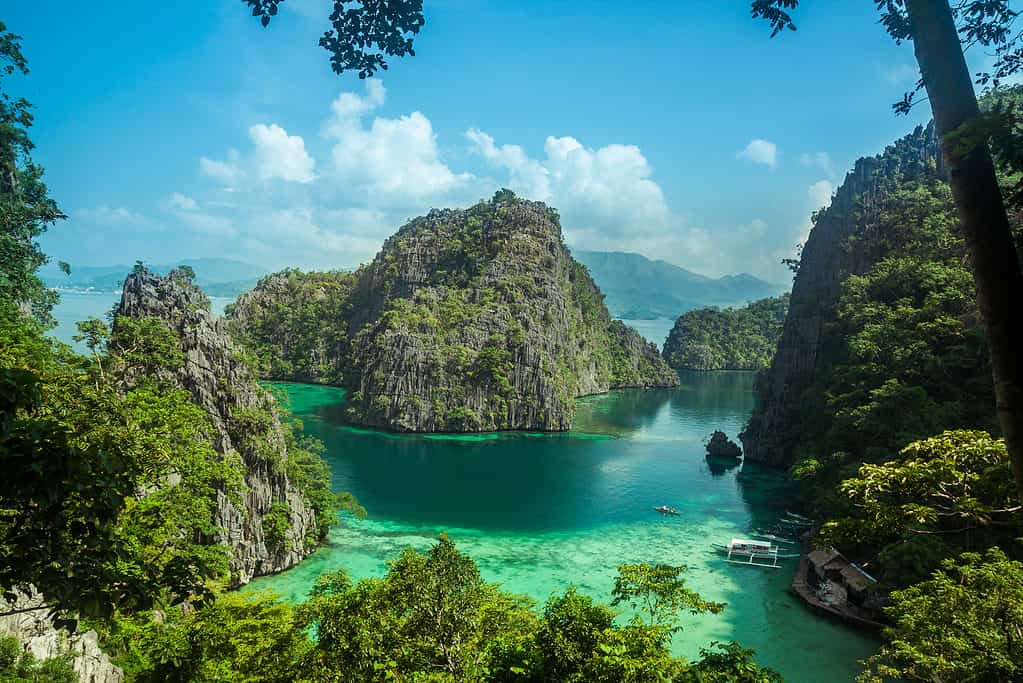
The fisherman who found the giant clam housing the Pearl of Puerto found the clam in the waters of the Philippines Sea.
©Kasia Soszka/Shutterstock.com
The Pearl of Puerto has not always lived under the bed of the fisherman. It was found on a stormy night in the Palawan waters, located in the western Philippines. This body of water is famous for its clear, turquoise waters and diverse marine life.
The area is also home to a number of coral reefs, including the Tubbatha Reef, a UNESCO World Heritage Site. After the fisherman handed the pearl to his relative, specialists from the University of the Philippines examined the treasure. It was later presented to the city’s mayor and displayed at Puerto Princesa, the capital of the island chain, where it is still on display today.
The “Pearl of Puerto,” a 75-pound pearl, is currently on display as a tourist attraction in the atrium of the New Green City Hall in Puerto Princesa. The pearl is still the fisherman’s property because he hasn’t signed it over to the government, according to the government spokesman for Puerto Princesa.
The Pearl of Puerto, the Giga Pearl, and the Pearl of Lao Tzu (Pearl of Allah) are all rare, natural pearls that come from large clams found off the coast of the Philippines. Currently valued at over $100 million, the Pearl of Puerto would be a lifelong fortune for the fisherman if it is eventually sold.
Facts About the Biggest Pearl in the World
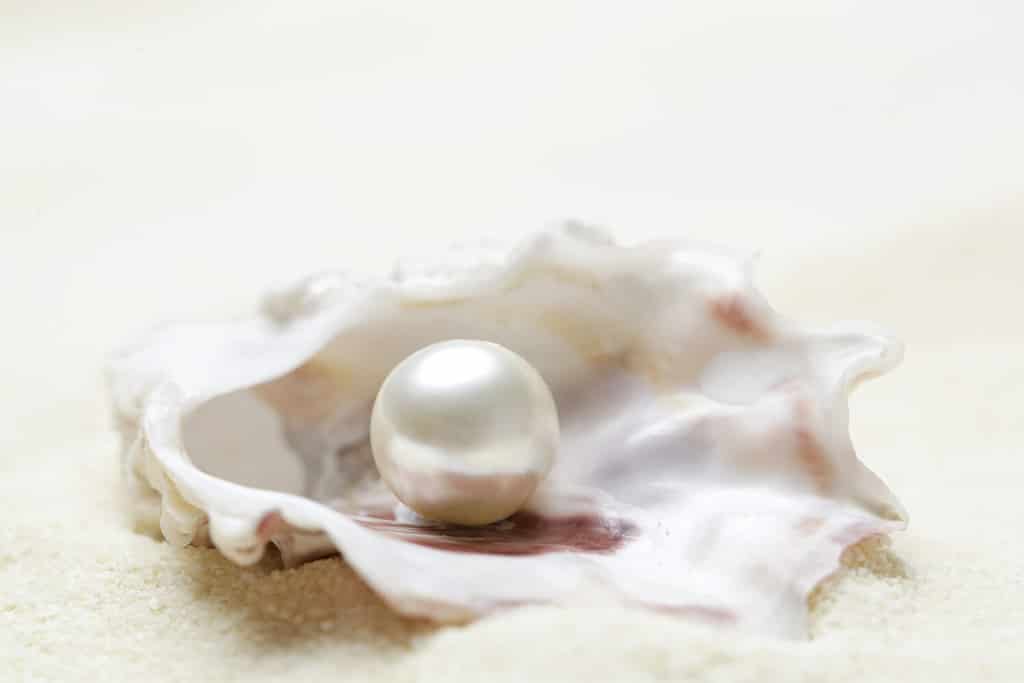
Nacre is the element that gives pearls their glorious luster.
©triocean/Shutterstock.com
The Pearl of Puerto is not just the biggest pearl in the world but also the most expensive. The size of the gem is not the only feature that makes it so special. It is also rare since it is a natural pearl. Here are a few facts about natural pearls:
- Natural pearls are extremely rare. The vast majority of pearls on the market today are cultured pearls formed by human intervention.
- Natural pearls are the only gems from living organisms. They form when an irritant, such as a small piece of sand or a parasite, enters the mollusk’s shell. The mollusk secretes a substance called nacre to cover the irritant, eventually forming a pearl.
- The size and shape of natural pearls can vary greatly. They can be round, oval, or irregular, like the Pearl of Puerto.
- The color of the pearl often depends on the type of mollusk that produced it and the water condition in which it lived.
- Like all natural pearls, the Pearl of Puerto’s value is based on unique attributes like size, color, and luster.
- Collectors seek natural pearls because people consider them a symbol of wealth and luxury.
- All recorded giant pearls in the world, including the Pearl of Puerto, came from Palawan Waters. The Palawan is also home to over 600 species of fish, 360 species of coral, and thousands of other marine species.
What Is the Rarest Pearl in the World?

Melo Melo pearls are the rarest in the world, formed inside the shell of the giant Melo Melo sea snail.
©GlobalGemology / CC BY-SA 4.0 – License
The rarest pearl in the world is a marvel of nature because it is not produced by a clam or mollusk at all–rather, it comes from a sea snail. Pearls produced by sea snails are called Melo Melo pearls. They are non-nacreous pearls that occur naturally, formed within the shell of a giant melo melo sea snail. As with other pearls, irritants can seep into the snail’s mantle and start forming secretions around it to relieve discomfort. The formation of a Melo Melo pearl can take decades.
The surface of a Melo Melo pearl is glazed and smooth, with varied colorations of tan, brown, or orange. Orange is the most sought-after color. Melo Melo snails inhabit the South China Sea and the Andaman Sea. The best Melo Melo finds have occurred around Vietnam.
Conclusion
What is the biggest pearl in the world? Again, it’s relative to what you define as the biggest, and what kind of pearl you are talking about. We’ve established that the largest known nacreous pearl is the Pearl of Asia. The largest certified non-nacreous pearl is the Giga Pearl. But there’s no denying the enormity of (or the excitement surrounding) the Pearl of Puerto. It may take some time for experts to declare whether or not the Pearl of Puerto deserves the title of the biggest. For now, it’s open to debate.
The photo featured at the top of this post is © Ingvars Birznieks/Shutterstock.com
FAQs (Frequently Asked Questions)
How Much Is the Pearl of Puerto Worth?
The Pearl of Puerto has an estimated value of $100 million. It is the world’s most valuable pearl.
Who Owns the Pearl of Puerto?
The fisherman who found the Pearl of Puerto is currently anonymous. The largest pearl in the world belongs presently to this fisherman, who remains unnamed and has not sold it or signed it over to the government.
Where Is the Pearl of Puerto Now?
The world’s largest pearl, the Pearl of Puerto, is currently on display at the New Green City Hall in Puerto Princesa as a tourist attraction.
Why Was the Biggest Pearl in the World Hidden?
The fisherman who discovered the Pearl of Puerto kept it under his bed for ten years. He kept it as a good luck charm for many years.
Thank you for reading! Have some feedback for us? Contact the AZ Animals editorial team.



